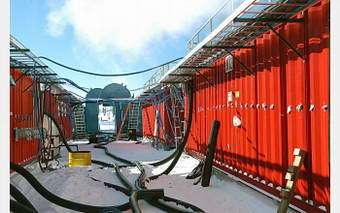World-class Physics at the Bottom of the World To Be Featured in Global Webcast

On Dec. 1, scientists at the National Science Foundation's Amundsen-Scott South Pole Station will participate in a live, worldwide webcast in conjunction with the World Year of Physics (WYOP).
Image: Equipment and buildings support the IceCube drilling project at NSF's Amundsen-Scott South Pole Station. Credit: Peter West, National Science Foundation
Web cast now live at beyond-einstein.web.cern.ch/beyond-einstein/
South Pole Station is the site of two major physics facilities. One detects the arrivals and trajectories of elusive subatomic particles called neutrinos to study enormously powerful astrophysical processes that occur at cosmological distances. The other examines properties of the cosmic microwave background--the faint radiation afterglow of the big bang that brought the universe into being--for clues about how the universe arrived at its present structure.
Scientists with both projects will discuss the significance of their work, which is taking place in one of Earth's most forbidding venues for astrophysics observatories, as part of a 12-hour global webcast titled "Beyond Einstein." The event is organized by CERN, the European Organization for Nuclear Research, to cap the WYOP, which ends this month.
WYOP is a celebration of physics and its importance in everyday life. It is being held this year because 2005 marks the 100th anniversary of Albert Einstein's "miraculous year" in which he published three important papers describing ideas that have since influenced all of modern physics. For more information about the specifics of Einstein's landmark discoveries, see the NSF Web site's special report on the WYOP: www.nsf.gov/news/special_reports/wyop/index.jsp
The webcast will feature on-camera discussions and interviews with researchers from the IceCube collaboration, which is constructing the high-energy neutrino observatory and includes 27 universities and institutes from the United States, Germany, Sweden, Belgium, Venezuela, Japan, the Netherlands, New Zealand, and the United Kingdom. An NSF award to the University of Wisconsin-Madison will cover most of the $272 million cost of IceCube, an array of neutrino detectors that will extend over a 1 cubic-kilometer area centered 2 kilometers beneath the ice sheet at the South Pole Station.
The webcast will also feature a research team that is using extremely sensitive radio telescopes at the Pole to study minuscule but information-rich variations in the cosmic microwave background. Researchers will discuss how their work can help unlock the secrets of how the universe was formed and share insights about how dark matter and dark energy contribute to the shape and distribution of mass in the universe today.
Both scientific teams receive support from the U.S. Antarctic Program. NSF manages the Antarctic Program and coordinates all U.S. science on the southernmost continent and in the Southern Ocean.
Source: NSF


















